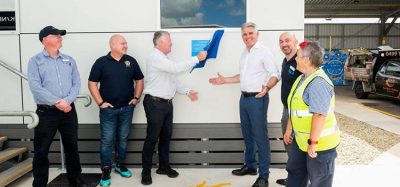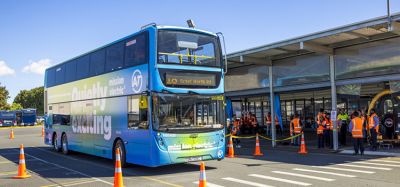Intelligent Transport: Addressing global mobility needs
- Like
- Digg
- Del
- Tumblr
- VKontakte
- Buffer
- Love This
- Odnoklassniki
- Meneame
- Blogger
- Amazon
- Yahoo Mail
- Gmail
- AOL
- Newsvine
- HackerNews
- Evernote
- MySpace
- Mail.ru
- Viadeo
- Line
- Comments
- Yummly
- SMS
- Viber
- Telegram
- Subscribe
- Skype
- Facebook Messenger
- Kakao
- LiveJournal
- Yammer
- Edgar
- Fintel
- Mix
- Instapaper
- Copy Link
Posted: 3 October 2017 | Brian Masson (Director of Multi Modal Transport Solutions Ltd) | No comments yet
Brian Masson, Director of Multi Modal Transport Solutions Ltd, discusses the launch of Intelligent Transport, the direction the transport industry is going, the reasoning behind the launch and what readers can expect from the new brand…
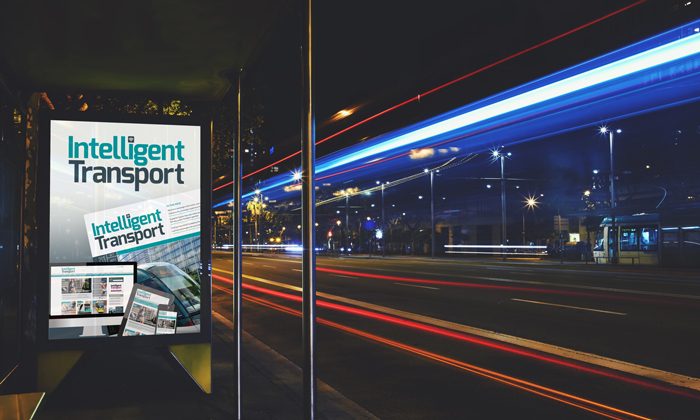

The decision to rebrand Eurotransport magazine as Intelligent Transport has been made to reflect the current and future needs of our readers and other transport stakeholders across the world.
The planet is facing ever-increasing challenges that impact the environment, economies and the lives of everyone. The design of solutions in most cases involves technologies which are being adopted and designed across the world. We at Russell Publishing have recognised the need to have a global brand to reflect these opportunities.
Intelligent Transport will provide an opportunity for transport authorities, operators, research centres and suppliers to promote their work, demonstrating the challenges they faced and how they have tackled them, highlighting the technologies, policies and procedures required to succeed.
Why change now?
Technological advances in the design of our vehicles moving away from fossil fuels toward cleaner solutions is a global challenge. Data-driven mobility solutions such as Uber and Lyft are having a huge impact on cities across the world. New global business models such as MaaS are now also coming on stream.
The challenge for any publishing house is to reflect the needs of its customers. Russell Publishing has listened to its readers and has recognised that there is a need for a global magazine that that can promote the best practice globally in the field of intelligent transport. It is our intention to source global challenges and solutions and demonstrate how these have been tackled, highlighting the needs of transport authorities and operators and how they have worked with policy makers and suppliers to design solutions.
The publication will be available to subscribers in printed, online and social media formats. Furthermore, regional events will be held to promote the topics that we feel our readers are interested in, helping them to understand the challenges and opportunities that can arise from accessing global solutions.
These are exciting times for the mobility sector. Intelligent Transport will be published every three months, focussing on the needs of the global mobility market. Our publication will assist technology suppliers in understanding the opportunities and promote their products to operators and authorities throughout the world focussing on the following core topics:
Smart Cities
Throughout the world, cities are facing numerous challenges including; increasing population, congestion, pollution and social and economic pressures. The availability of ITS technologies to gather data from traffic movements, passenger data, etc. assist cities to design and plan more efficient solutions to meet these challenges.
The integration of ITS systems has demonstrated many advantages and helped develop new products and methods to resolve mobility problems in our cities. This approach has resulted in new service models such as Bus Rapid Transit using ITS in South America, Asia, Africa, Australia, and North America. These services have seen significant growth in passenger numbers and reduction in car use. In Europe BHLS Buses with a ‘High Level of Service’ have also seen the benefits of using ITS to make services more attractive.
The European Union has set out its vision on https://ec.europa.eu/transport/themes/its_en: “Innovating for the transport of the future Intelligent Transport Systems (ITS) are vital to increase safety and tackle Europe’s growing emission and congestion problems. They can make transport safer, more efficient and more sustainable by applying various information and communication technologies to all modes of passenger and freight transport. Moreover, the integration of existing technologies can create new services. ITS are key to support jobs and growth in the transport sector. But in order to be effective, the roll-out of ITS needs to be coherent and properly coordinated across the EU.
“The European Commission is working with Member States, industry and public authorities to find common solutions to the various bottlenecks for deployment. Through financial instruments, the European Commission supports innovative projects in ITS and through legislative instruments it ensures that ITS are rolled out consistently.
“In the coming years, the digitalisation of transport in general and ITS in particular are expected to take a leap forwards. As part of the Digital Single Market Strategy, the European Commission aims to make more use of ITS solutions to achieve a more efficient management of the transport network for passengers and business. ITS will be used to improve journeys and operations on specific and combined modes of transport. The European Commission also works to set the ground for the next generation of ITS solutions, through the deployment of Cooperative-ITS, paving the way for automation in the transport sector. C-ITS are systems that allow effective data exchange through wireless technologies so that vehicles can connect with each other, with the road infrastructure and with other road users.”
Intelligent Transport will be highlighting how cities across the world have used ITS to improve public transport to offer more attractive solutions.
Digitalisation
The availability and use of data generated from personal and other sources is impacting on every aspect of society. Products and services are designed to meet known demands 24/7. How are public transport authorities and operators responding to the benefits of digitalisation? What are the issues? What are the benefits? How much does it cost to manage and operate? Who is responsible for data security? Who ‘owns’ the data? How do we build trust in systems, procedures and products?
The design of any product, including public transport services, should be based on meeting the needs of its customers. The availability of useful data is aiding authorities and operators now understand the who, why, where, when and what the needs of passengers are.
Crowdsourcing is a technique that is being adopted by many operators to engage with stakeholders and involve them in the design, monitoring and evaluation of services.
The availability of data also allows manufacturing business methods like Lean to be adopted where all stakeholders can work together in the design of services, reducing wasteful working practices and procedures and focussing on the needs of the customer.
Intelligent Transport will be reporting on global best practice and aiding the understanding of issues for stakeholders.
Intermodality
Meeting the mobility needs of individuals in any area depends on a range of factors including geography, demographics and individual ability, both health and financial. No single mode can meet the total needs of society. Multimodal transport solutions are required to cover the wide range of demands.
Whilst public transport services like bus, coach, train, tram and metro can meet most needs, the ability or willingness to make the first- and last-mile connections can often make it unattractive for many people. In some areas like Netherlands, Denmark and Sweden, significant investment has been made in cycling infrastructure to encourage people to switch from car to public transport, improving congestion, health and air quality. The design of our public transport services should consider the needs of communities and ensure infrastructure is provided to support multimodal integrated transport.
Aging populations are also having an impact on transport demands globally. Demand-responsive transport services and new business models like MaaS are now making it possible to provide solutions using smart technologies to plan, book and pay for multimodal transport services.
Intelligent Transport will highlight global best practice to promote how intermodality can assist transport authorities and operators across the world to meet their challenges.
Ticketing and payments


Ticketing systems throughout the world have changed dramatically over the past 10 years with the introduction of smartcards, smart devices and card reading technologies. The current trend is moving towards multimodal ticketing using apps on smart devices such as Maas Global Whim and smartcards. What are the issues for transport authorities, operators and ticketing providers? What are the impacts on passengers without access to smart devices? How can we ensure that public transport remains affordable for everyone? What are the costs associated to the ticketing agency and who pays? How reliable are the technologies?
Intelligent Transport will highlight best practice from operators and authorities globally allowing greater understanding of issues and help break down barriers.
Safety and security
Safety and security both on and off vehicles is a major factor for all transport authorities and operators. Technologies including CCTV, WiFi, radio communications and driver monitoring are now widely used by operators and authorities.
In a world faced by increasing threats that can impact on public transport it is important that we can learn from sites across the world about how policies, procedures and products have improved security levels.
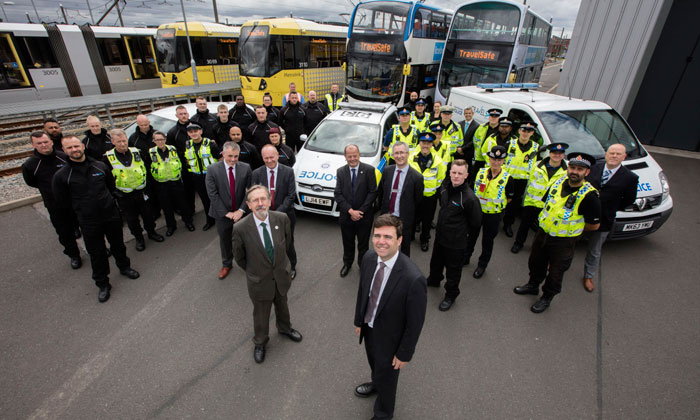

Infrastructure also needs to be safe and secure – how do we improve the design of our bus stops, shelters, bus stations/interchanges to improve safety and security?
Intelligent Transport will help to promote how transport authorities globally have worked with operators and suppliers to develop new methods and products to meet local demands.
The passenger
The needs of passengers should be the focus for transport authorities and operators. How do transport authorities and operators across the world interact with passengers? What role do passengers have in the design of services, vehicles and products?
Intelligent Transport will be promoting how the needs of passengers are recognised globally. This will include special focus on school, elderly and disabled people. Driver and staff training standards across the world will also be explored to aid understanding of issues.
Increasing elderly population and meeting the needs of people with disabilities is also a challenge. Intelligent Transport will highlight the array of new technologies and working practices that have and are being developed across the world. This will allow passenger groups globally to share best practice and aid service and product development locally working with transport authorities and operators.
The Fleet
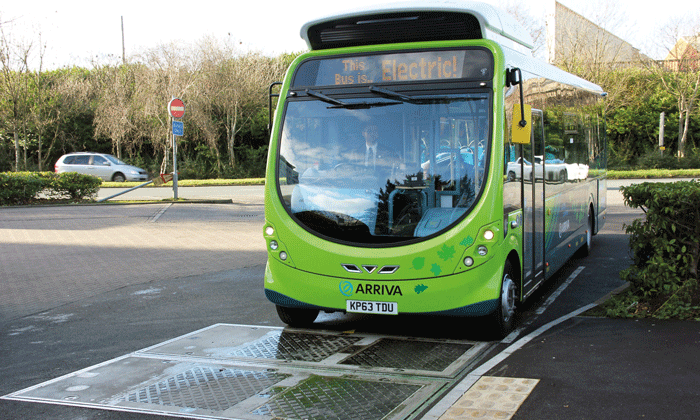

The choice of vehicle available to transport authorities and operators is greater than ever. Regulatory frameworks are now placing high emphasis on environmental issues such as noise and emission pollutants. The option of hybrid, hydrogen, electric, gas, diesel, trolley bus and bio fuel are all available.
Which is best for any area and why? The success of each type of vehicle needs to be reported to aid understanding of the issues and opportunities that exist. Understanding the capital and running costs is important.
Supporting infrastructure is required for electric and hydrogen vehicles. Who pays? What are the costs? What is the return on investment?
Accessibility for elderly and or disabled people, prams, passenger comfort, security, passenger information, Wi-Fi are all now seen as essential in the design of vehicles. What else can we expect in the future?
What will be the impact of driverless buses?
Intelligent Transport will report on the performance of vehicles, supporting technologies etc. throughout the world and highlight current research and policy implications.
Regulation and legislation
The development of public transport services requires a regulatory framework to ensure quality and safety levels are adhered to by all operators. Innovation can lead to new business models that do not fit into existing regulatory frameworks. The likes of Uber have seen legal challenges in courts throughout the world. What types of regulation and legislation encourage innovation and at the same time safeguard passengers, employees and congestion in cities? What are the political challenges?
The powers of any PTA are defined by regulations that govern the modes of transport and functions of the authority. These regulations have to be fully understood by all stakeholders to avoid any confusion and possible conflicts. The following table highlights possible sources of legislation:
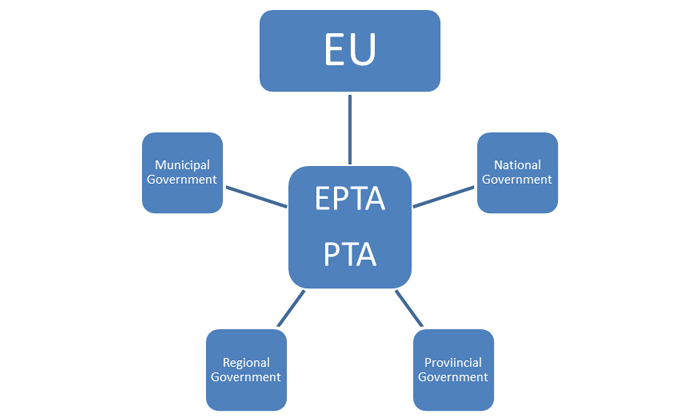

Regulation bodies
The levels and powers of government varies from country to country and impacts on the success of its transport policies. It is important that the role of regulation is critical in the design of any PTA. A successful PTA structure in one country may not be a transferrable model due to a number of factors for example, political support and operational conditions may vary from area to area or country to country.
Each level of government is politically accountable and subject to elections. This can lead to changes in priorities and commitment to policies including transport. With this in mind, this best practice guide to PTAs is designed to give a snap shot of what is and has been achieved at various sites throughout Europe.
The policies that PTAs will be responsible for will be defined by politicians. These will usually cover the following political objectives:
- Reduce car use
- Increase public transport use
- Increase car sharing
- Increase social inclusion
- Increase cycling
- Increase walking
- Reduce journey times for all modes
- Reduce journey times for sustainable transport modes
- Reduce accidents
- Reducing parking demand
- Reduce total person kilometres
- Increase the accessibility of the transport system to people with mobility problems
- Make transport more affordable
- Increase economic development
- Increase participation in labour market
- Improve air quality
- Improve access to health facilities
- Improve access to education
- Improve access to training
- Improve information regarding public transport
- Improve land use
Intelligent Transport will report on global best practice and demonstrate what solutions have worked best in any given environment.
Business models
Throughout the world there are numerous business models governing public transport sector.
Management contract, gross cost contract, net cost contract, super incentive contracting, franchising, deregulated, cooperative frameworks, MaaS and Demand Responsive Transport (DRT) are all examples of existing business models. What is the best option to encourage innovation and meet the needs of communities in a sustainable, environmentally, safe and economic manner?
Transport authorities across the world are facing cuts to budgets, environmental pressure to improve air quality and reduce congestion. Operators want to increase the number of passengers being carried.
New models like Uber are seen as a threat by some operators and authorities. How will the development of MaaS type models work in practice? Will operators willingly participate in schemes? Who will pay the ticketing agency?
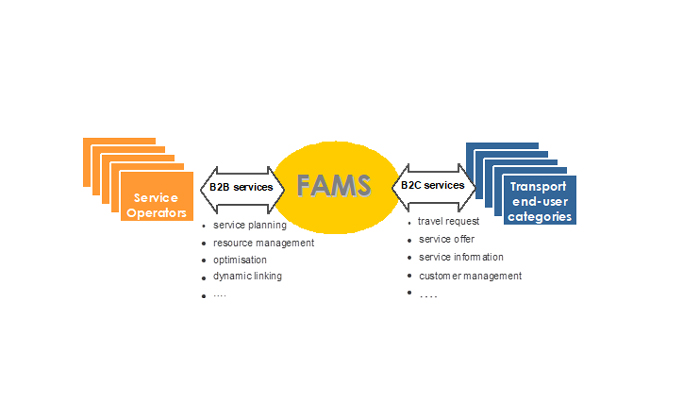

The FAMS DRT business model
The FAMS view
So far, DRT services have been applied mostly as a single element of a potentially larger intermodal transport chain. Most often DRT schemes have been – or are – operated as a single mode, by a single operator, with little or no integration with the other transport schemes. However, there are large opportunities for the improvement of the service provision modalities and of the service model itself by strengthening the co-ordination of different intermediate services and their integration within the overall transport service chain.
FAMS (which stands for Flexible Agency for Demand Responsive Collective Mobility Services) is aimed at improving demand responsive, intermediate transport by addressing fundamental organisational and technical issues at the heart of this kind of transport model: improving communication, integration and co-operation amongst all the actors involved in the DRT domain, e.g. transport service planners, transport providers and end-users.
Existing DRT management tools have been adapted and made interoperable within an e-business collaborative environment. Models and solutions to enable collaboration among transport operators are based on currently available e-commerce/e-business technologies such as n-tier web-based architectures, portal technology, distributed web services, internet communication and notification services, information and resource-sharing techniques over smart devices, social media and the internet. This allowed improved co-operation among transport service suppliers and operation of a new service value chain.
FAMS is essentially aimed at experimenting with concepts for a ‘Flexible Agency’ enabling coordinated provision of DRT services in an area. Flexible here means not only flexibility in the transport schemes, but also flexibility in organising the provision of DRT services in a multi-service and multi-operator context. This flexibility of work and operation is embodied in the concept of a Flexible Agency, enabled by a number of e-business and e-commerce services.
Intelligent Transport will report on the varying business models used across the world and aid development of transferrable models through greater understanding of the issues and opportunities.
Intelligent Transport
Intelligent Transport has been designed to meet the needs of global public transport market raising awareness of issues, challenges and solutions. The printed and online publication will be supported by social media, web, webinars and conferences. This is a time for change and Intelligent Transport has been designed to assist all stakeholders to understand and promote issues through one single publication.
Today we can all become part of the new global world of Intelligent Transport. With your support, we can help promote best practice to aid the development of improved services locally, nationally and internationally.
Related topics
Air Quality, Alternative Power, Intelligent Transport Systems (ITS)
Related modes
Bus & Coach
Related cities
United Kingdom
Related people
Brian Masson




